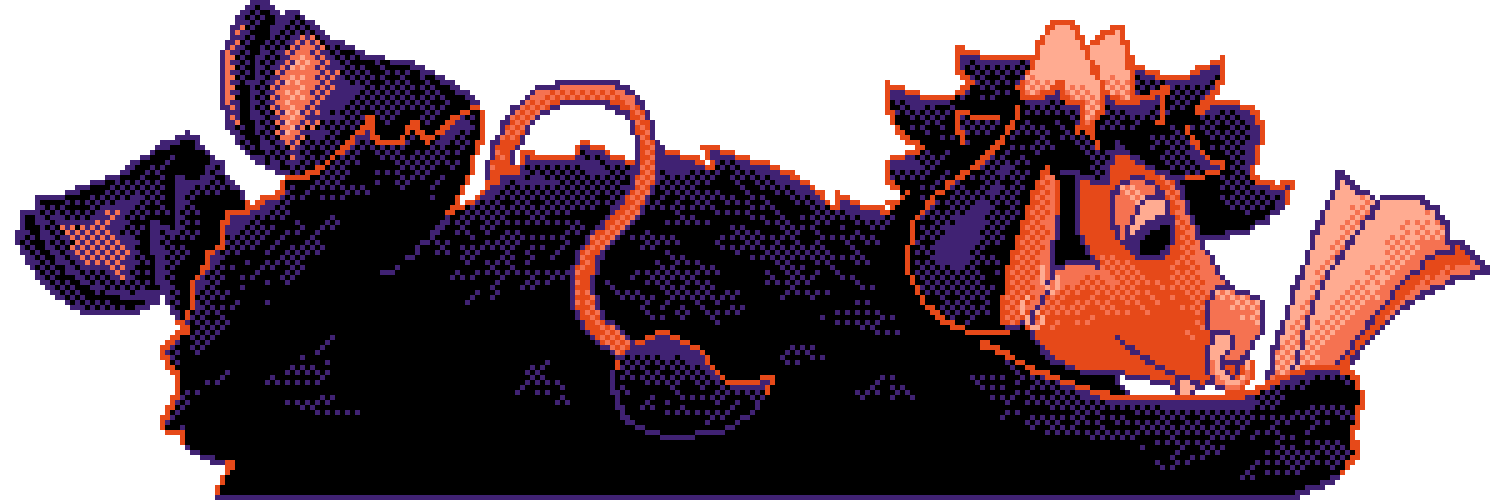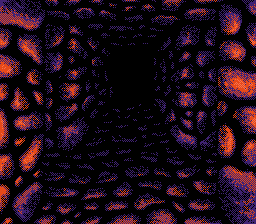
Decap Robot Band
I love street organs and other music automatons! They're a very early use of binary code and a predecessor to modern animatronics, some even include simple figures that we'd recognize as automatons today.
The Decap dance organ Robot Bands were made in the 1950's and 60's, reportedly only 10 exist. These consist of 7 92 key instruments and 3 105 keys. Most of the stages have three robot musicians: a drummer, a saxophone player, and an accordion player, but there issome varriation. One of the stages has a piano player, and the largest stage features two accordions on the wall of the organ itself, and the accordion playing robot replaced with a smaller horn.
If a catalogue of the different sizes, locations, and makeup of these organs exists, it isn't searchable on the English internet, since these organs were created in Belgium. Below is what I've able to piece together from a few hours of googling and learning to recognize each band, since from what I can tell each is a completely unique creation. The nicknames below are unofficial, save for "De Blauwe Engel", and are just made up by me to keep track in my head.
DeCap & other Organs
- Dr. Ted's Musical Marvels - Decap
- Decap in general, no mention of the Robot Band
- American Treasure Tour - frer decap dance organ
- Decap in general, no mention of the Robot Band
- Decap website
- Decap in general, no mention of the Robot Band
- YouTube: Arnold Chase Collection Tour
Leads for More Research
- The Musical Box Society - Decap Robot Orchestra
- Mechanical Music Digest Archives - Decap Robot Bands in the United Kingdom
- iMOD - The Free and Independent Mechanical Organ Discussion Forum
- Musical Box Society of Great Britain - The Music Box journal archive
- the index lacks searchable terms for Robot Band, Decap, or Krughoff, but these are still wonderful reads and will likley have more information hiding
- YouTube: William Mostmans' YouTube, works for DeCap and posts videos
- Carousel Organ, Issue No. 4
- Carousel Organ, Issue No. 31 — April, 2007
- Mechanical Music Digest Archives Mon 17 Nov 2014
- Forum post that mentions an upcoming publication with more information on the DeCap robots, I wasn't able to find it.
- Douglas-Self
- A personal site where I found a lot of info, has a contact email
Misc
DeCap Organs
105 Key "We play for tips"
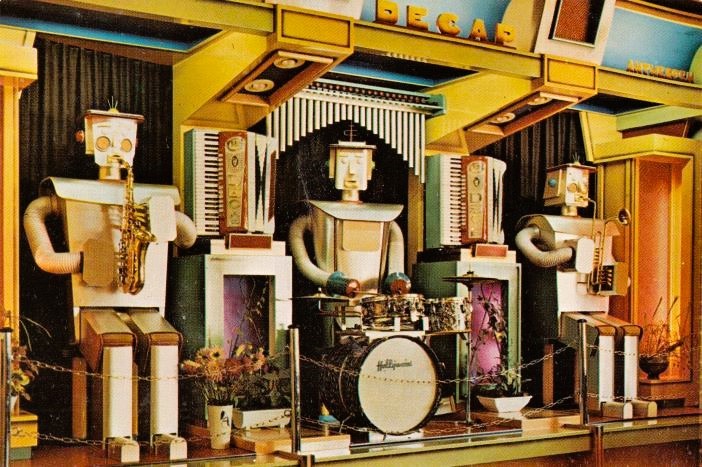
This notable larger model has two horn players and no accordionist, with the accordions as part of the organ facade instead. A small stationary robot stands on the left, and a small sign saying "We play for tips" is sometimes seen in its recent homes. It was originally installed at the Hotel Eemland in Soest, Netherlands. It then played for Turners Musical Merry-go-round soon after their opening in 1983, until an unknown date before or at the attraction's closing in 2004. It resided in the private collection of Henri Krijnen in Oosterhout, Netherlands until being sold in auction in 2022 for $350,550 to Ozzie Bilotta in Florida. The Bilotta Collection is a museum of toys and animatronics Ponte Vedra Beach, Florida.
- Last known location: Bilotta Collection, Ponte Vedra Beach, Florida (Public, by appointment)
- Band members (L to R): Saxophone, Drums, Horn
- Backdrop: Black curtain, visible chimes
- Robot cosmetics: Shiny silver, no decals on the hands or chests
Previous
- YouTube: Can 036 Robot Music (1 Oct 1963)
Turners Musical Merry-go-round

- The Music Box spring 1987
- BBC, Robot organ plays a tune at Northamptonshire indoor fairground
- YouTube: 105 Key Decap Robot Dance Organ, Ex. Turner's Merry-Go-Round (Taken from one of the souvenir LP records of the long gone Turner's Musical Merry-go-Round in Northampton.)
Henri Krijnen
- AC Pilmer Automatic Music Ltd - Gebroeders Decap Robot Organs
- Restoration of this 105 key
- They also restored the “Blue Angel” 105 key Robot Band in the Krughoff collection
- YouTube: Decap Robotorkest
- YouTube: Gebr. Decap Robot Organ by Mechanical Entertainment Museum
- Douglas-self, Mechanical Musical Instruments
- YouTube: Decap RobotBand
Auction & Bilotta Collection
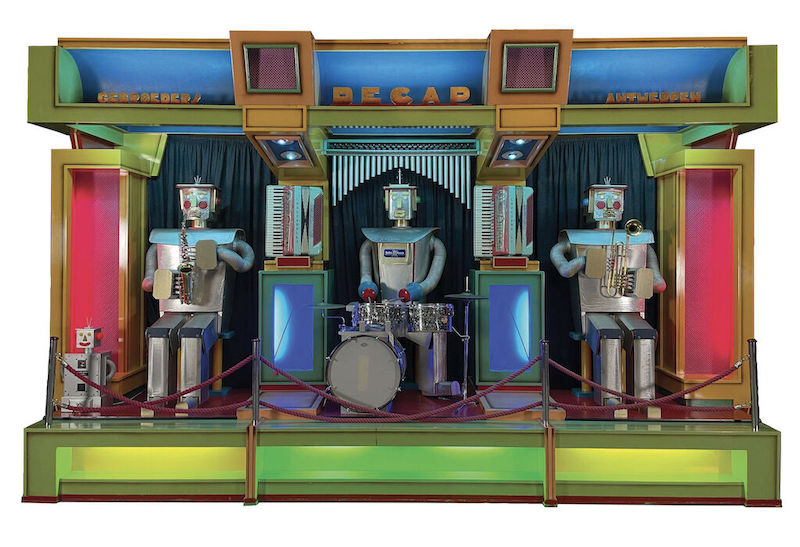
105 Key "De Blauwe Engel" or “The Blue Angel”
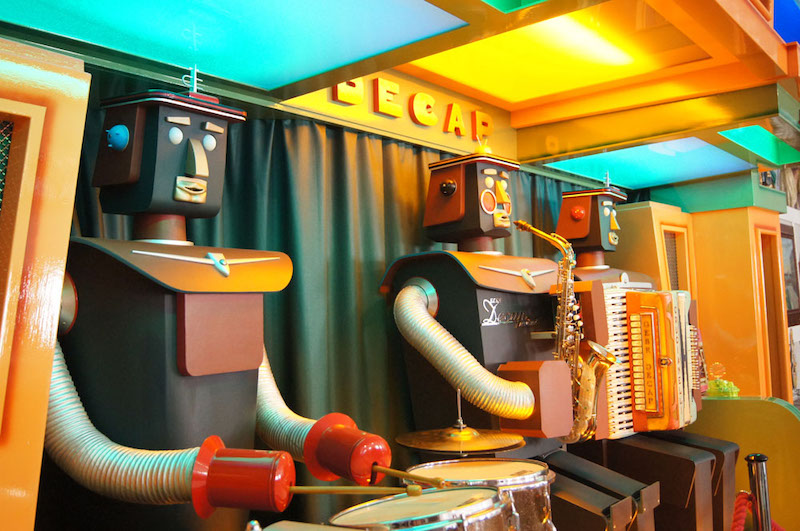

Originally from the dance cafe of the same name in Belgium. It was owned for a few years by Graham Whitehead and was presented at his Ashorne Hall establishment. After his death, it was moved to the Krughoff collection. After another death of the organ's owner, its current location is unknown.
- Last known location: Krughoff collection, United States. (Private?)
- Band members (L to R): Drums, Saxophone, Accordion
- Backdrop: Black curtain, "De Blauwe Engel" is written on the top of the procenium
- Robot cosmetics: Blue
- AC Pilmer Automatic Music Ltd - Gebroeders Decap Robot Organs
- Restoration of this 105 key
- They also restored the "We play for tips" organ above
- The Musical Box Society - Decap Robot Orchestra
- YouTube: Decap Robot Band
- YouTube: DeCap Robot Band
- YouTube: DeCap Robot Band
- YouTube: 105 Key Decap Dance Hall Organ "De Blauwe Engel" (the Blue Angel) Plays "Salvatore"
105 Key "Big Pipes”
The last 105 key, built in 2005 by DeCap to match the '50s models. It was comissioned by Cris van Laarhoven and Anthony (Toon) Heesbeen for the Museum Dansant in Hilvarenbeek, Netherlands, in the museum's dance hall. It still lived there as of 2009. In 2013, it was taken back to the DeCap factory at one point to be fitted with additional pipes, visible behind the players. As of 2018, this band now resides in the Museum Speelklok in Utrecht, Netherlands. Since it has performed in two public spaces, there are more recordings of this one.
- Last known location: Museum Speelklok, Utrecht, Netherlands. (Public)
- Band members (L to R): Drums, Saxophone, Accordion
- Backdrop: Black curtain, visible chimes and pipes (after revamp)
- Robot cosmetics: Grey bodies, red accents
Museum Dansant:
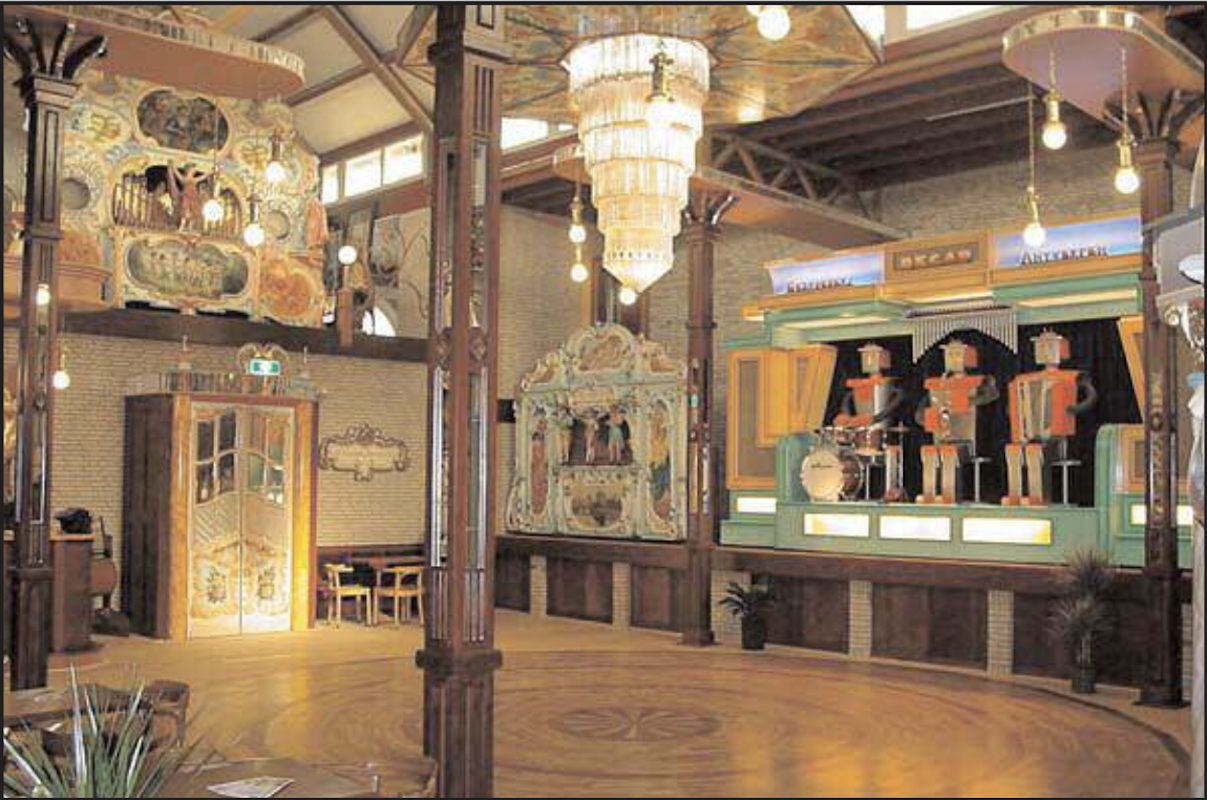
The Museum Dansant dance floor, surrounded by dance organs.
- Carousel Organ, Issue No. 31 — April, 2007
- YouTube: Decap Robotorkest Museum Dansant - Deel 1 (9 Aug. 2009)
- YouTube: Decap Robotorkest Museum Dansant - Deel 2 (9 Aug. 2009)
- YouTube: Draaiorgelmuseum Dansant, Hilvarenbeek 10-09-2017 #02
- YouTube: 105 Toets Robot Decap- Dansant @ Hilvarenbeek. 25-01-09
- YouTube: Decap Roboter Orgel Spielt Im Museum Dansant in Hilvarenbeek
- YouTube: 105 Toets Robot Decap- Dansant @ Hilvarenbeek. 25-01-09
- YouTube: Decap Antwerp Robot Organ (in factory, posted by a DeCap builder)
- YouTube: Decap Antwerp Robot Organ (2) (in factory, posted by a DeCap builder)
Museum Speelklok:

- Museum Speelklok Website
- YouTube: Decap Antwerpen Robot-Orgel-1 (post-revamp, also filmed in the factory)
- YouTube: Gebroeders Decap Antwerpen 105T Robotorgel
- YouTube: Decap Robot Band
- YouTube: Robots Play Music in Exhibition Robots Love Music at Museum Speelklok, Utrecht
- YouTube: Robot Decap in Museum Speelklok. Film: Nieuws030
- YouTube: 07-07-2018 Leerdam - Decap Dansorgel Robotorkest
92 Key "My Son"

Has a miniature accordion player down front. The uploader of the third video - swissmusicbox, says the band is for sale but the link in the description is no longer active :,(.
- Last known location: Kessler Collection, Zurich, Switzerland - now dispersed? (Private?)
- Band members (L to R): Drums, Saxophone, Accordion
- Backdrop: Black curtain with multi-colored space themed cutouts like stars, rockets, planets
- Robot cosmetics: Shiny silver including accents, with red, yellow, and green detailing. Drummer has a blue sticker or plate on their chest
- YouTube: Robot Decap 1957
- YouTube: Robot Decap 1957
- YouTube: Decap Robots
- YouTube: Robot Decap
92 Key "Fairground Follies"

- Last known location: Fairground Follies, Bowral, Australia (Public)
- Band members (L to R): Drums, Saxophone, Accordion
- Backdrop: Shiny gold curtain
- Robot cosmetics: Dark green bodies with gold accents, no detailing
92 Key "Middle Drummer"
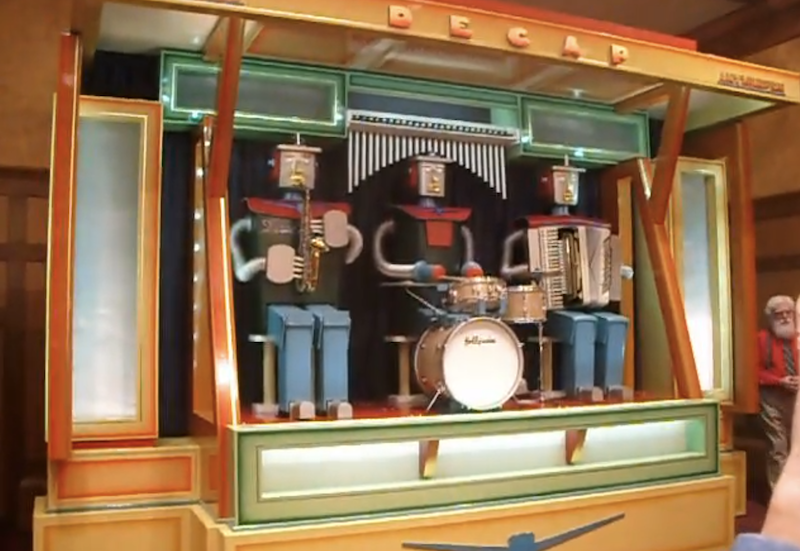
- Last known location: Arnold Chase collection, 2018 (Private?)
- Band members (L to R): Saxophone, Drums, Accordion
- Backdrop: Black curtain
- Robot cosmetics: Black and red, light blue pants
- YouTube: Amazing Robot Band
92 Key "Starry Blue"
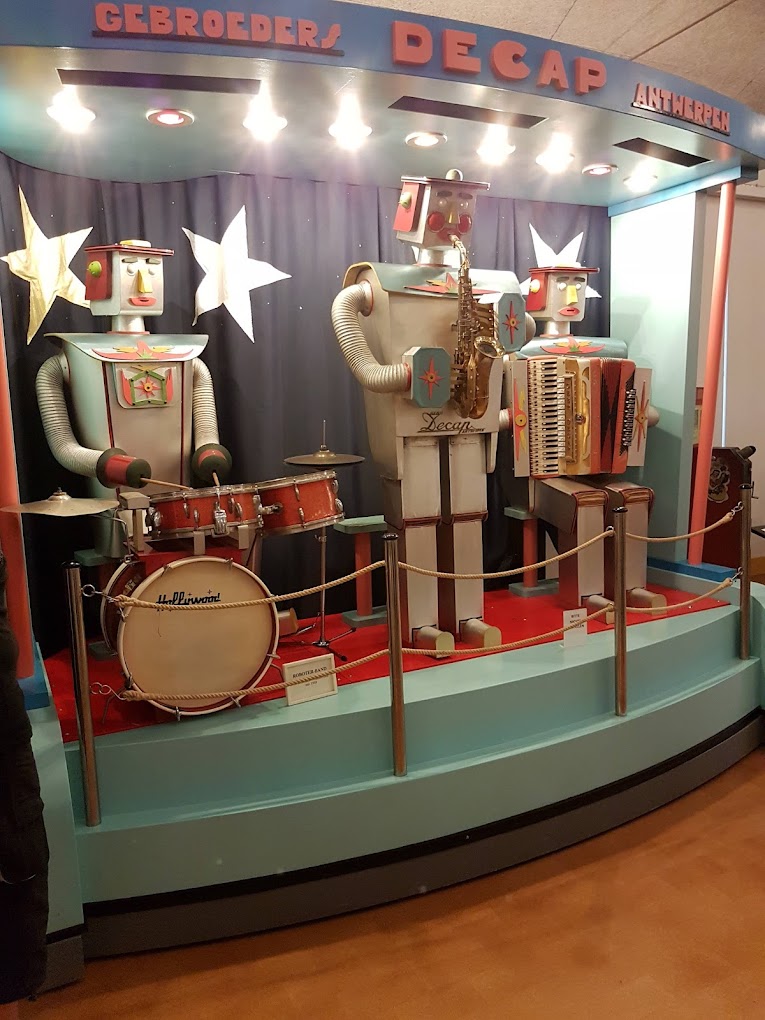
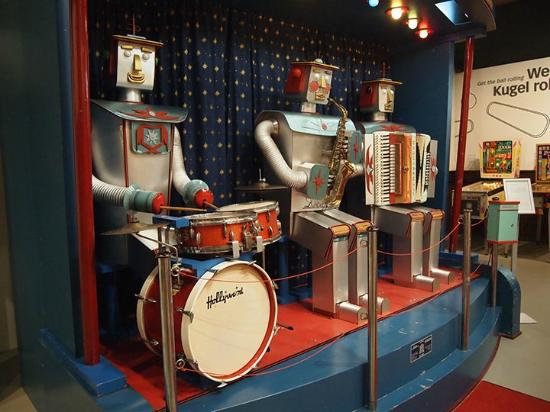
This band performs at the Deutsches Automaten Museum in Epselkamp, Germany, where it moved in 2023. Previous videos show it in an alcove with a curtain in front, but I have not discovered its previous location. The virtual tour of the Deutsches Automaten Museum shows a different DeCap organ in its place, but the photos were taken in 2022. A TikTok from the museum itself shows the robot band being moved into place in 2023.
- Last known location: Deutsches Automaten Museum in Epselkamp, Germany (2023) (Public)
- Band members (L to R): Drums, Saxophone, Accordion
- Backdrop: Dark blue curtain with stars
- Robot cosmetics: Silver and light blue
- YouTube: Decap Dansorgel - Robotorkest
- Deutsches Automaten Museum website (you can do a virtual walkthrough!!!)
- YouTube: Decap Roboterband
- YouTube: 92 Key Gebr. Decap Robot-Band - "Carolientje"
- YouTube: 92 Key Gebr. Decap Robot-Band
- YouTube: 92 Key Gebr. Decap Robot-Band - "Parisian Songs Medley"
- YouTube: Decap Roboter Band Im Automatenmuseum Espelkamp
- YouTube: Roboterkapelle
- YouTube: 92 Key Gebr. Decap Robot-Band - "Die Hälfte Seines Lebens"
- YouTube: Decap Roboterband
- TikTok: Deutsches Automaten Museum tiktok
92 Key "Eemland"
Built for the café-restaurant Eemland, Soestdijk (1961-1967). It's rumored this was the one that was destroyed in a fire, though I have found no confirmation besides my lack of modern footage in my research.
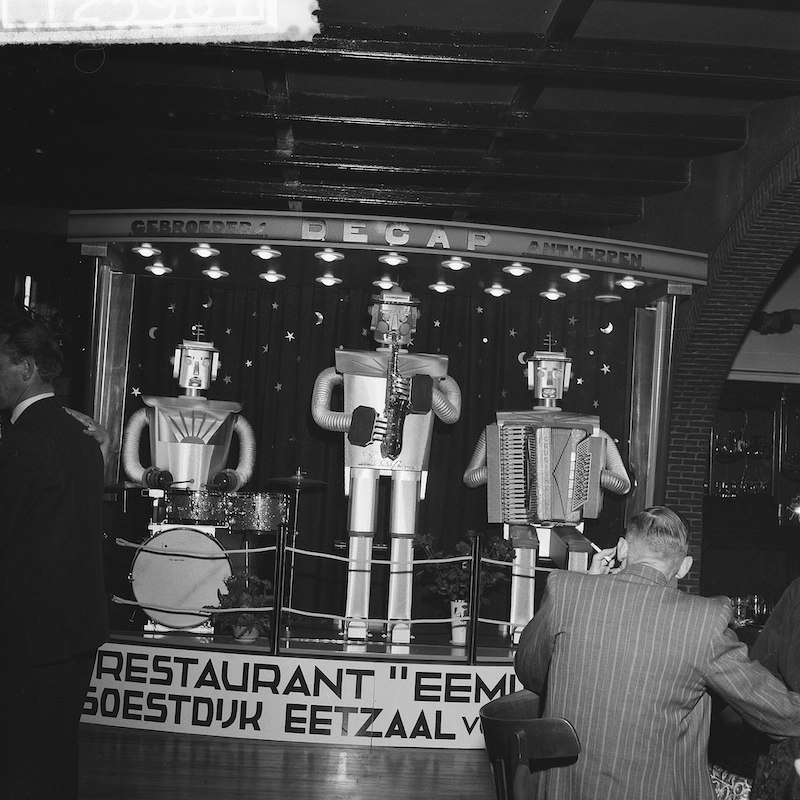
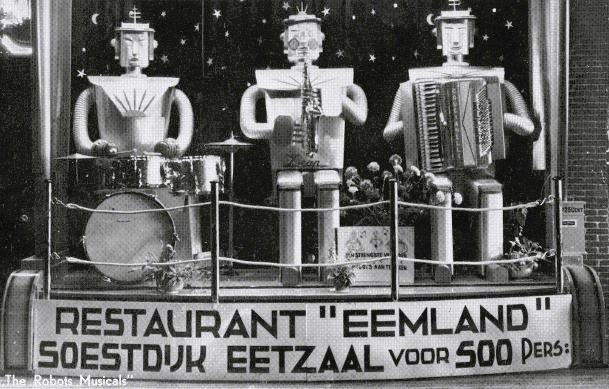
- Last known location: unknown
- Band members (L to R): Drums, Saxophone, Accordion
- Backdrop: Black with scattered stars
- Robot cosmetics: Silver, simplified "starbursts" on their chests
92 Key "Starry Black"
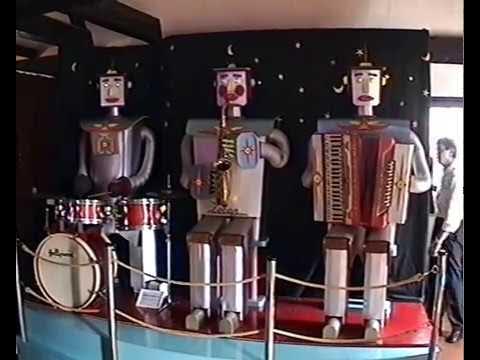
Video was taken at the Music Museum Linz, Germany. At some point, the band was moved to the Klangsmaschinen Museum, Durnten, Switzerland.
- Last known location: Klangsmaschinen Museum, Durnten, Switzerland (Public)
- Band members (L to R): Drums, Saxophone, Accordion
- Backdrop: Black with scattered stars, now black with large stars
- Robot cosmetics: Silver with light blue decals
92 Key "Moony Beam and the Shooting Stars"
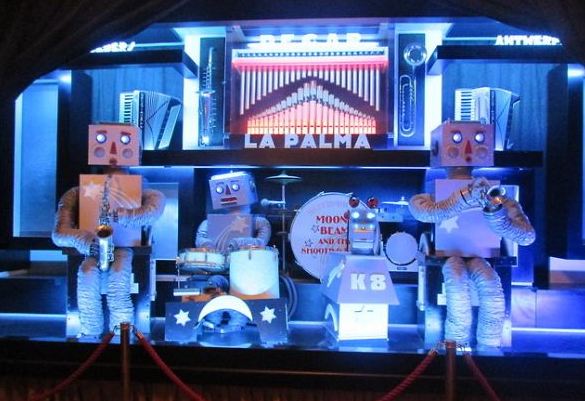
A completely different look, but an official DeCap organ! Moony Beam and the Shooting Stars are squat, square, and considerably cuter than the standard band. They even have a "k8", a reference to Dr Who's k9. This band lives at Watermouth Castle.
There are a lot more videos of these guys, I could spend a lot longer searching!
- Last known location: Watermouth Castle in Ilfracombe, Devon, England (Public)
- Band members (L to R): Saxophone, Drums, Trumpet
- Backdrop: Pipes, two accordions
- Robot cosmetics: Unique! Little boxy guys with duct arms
Unconfirmed leads
There was also a band at John Gresham's Penny Arcadia museum in Pocklington, England. The museum closed in 1994 and most of the collection was sold to Greg McLemore in 2004 for his video game museum in California. I was unable to find any records of where the organ ended up. Comments suspect that it was a two-robot band, and may have ended up in Australia. However, the known band in Fairground Follies, Bowral, Australia, is a standard three-bot.
I have repeatedly found comments saying that one of the organs was caught in a fire, but sources disagreed on which exact model it was, sometimes referencing bands currently active.
Other Robot Bands
Norman Kendall DeCap replica

Notably, the only band to include a piano! This organ was built by Norman Kendall and uses modern tech. These bots are grey and red, with tan heads. There is also sometimes an accompanying smaller bot named "Robert the Robot" separate to the trailer that houses the band.
Les Robots' Music: 1958
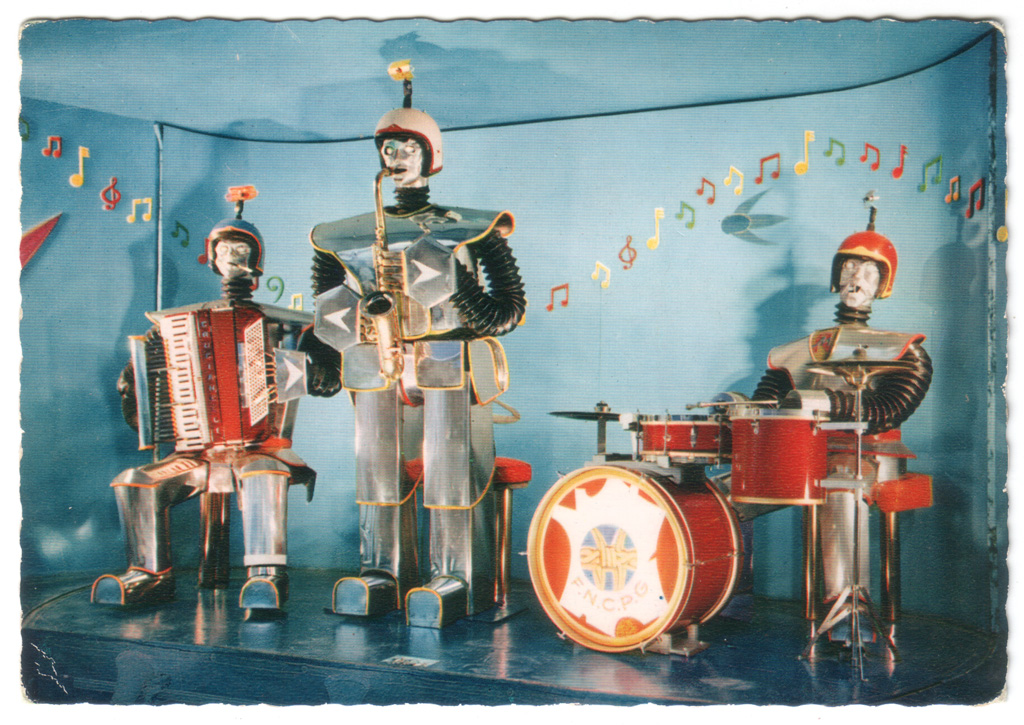
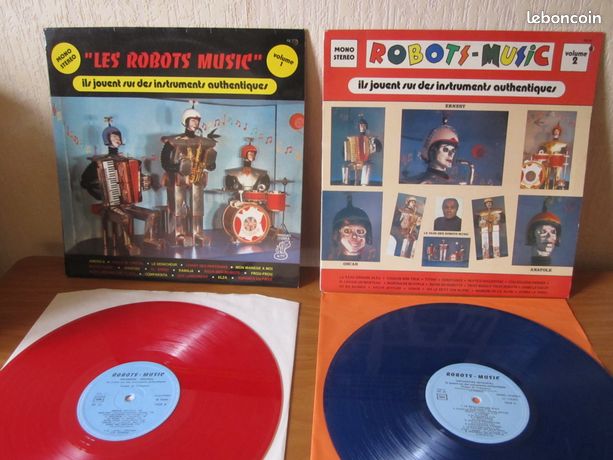
Robots' Music bears the most resemblace to the DeCap bands - most clearly in the shapes of the legs and hands of the players. They were created by Edouard R. Diomgar. They were last recorded in the Museum fuer Kommunikation, Berlin, in 2007. They have CD releases!
Unlike the DeCap band, these players have names! Oskar plays the accordion, Ernest the drums (with a real smoking cigarette between his metal lips), and Anatole is on the alto saxophone.
- Collecting robots on postcards – 7 – “Robots-Music”
- YouTube: Robots Music - La Bamba
- Douglas-self, Mechanical Musical Instruments
- neon-flamingo on tumblr
- YouTube: Zenon Specht's Robot Band, Trio Fantastique, 1950s (INCORRECTLY LABELLED)
- continuo - Les Robots-Music – vol.1
- Blog post about the albums from Les Robots-Music
- YouTube: Les Robots Music Rock Des Robots (album)
- discogs for all four albums
- Les Robots-Music Flickr 2007
- Atomic Flash Deluxe - The Robots – ‘They Play On authentic Instruments’
The Trio Fantastique: 1954
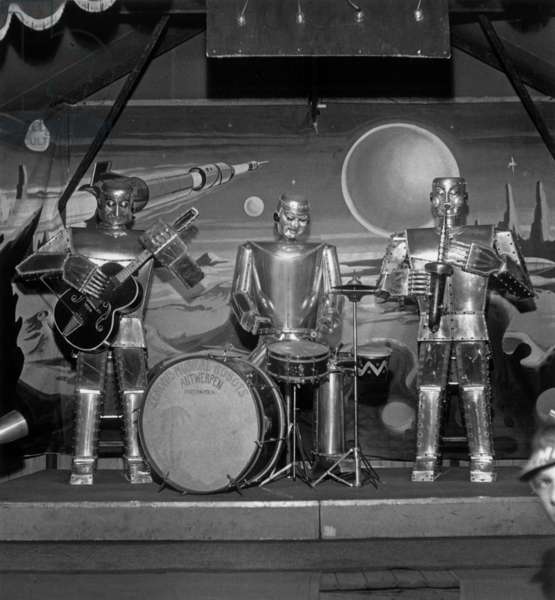
Built by a Belgian engineer named Zenon Specht. Another band with names! Wink is on guitar, Blink on drums, and Nod on alto saxophone. They were built for Specht's vanue, the Antwerp’s Robot Club.
